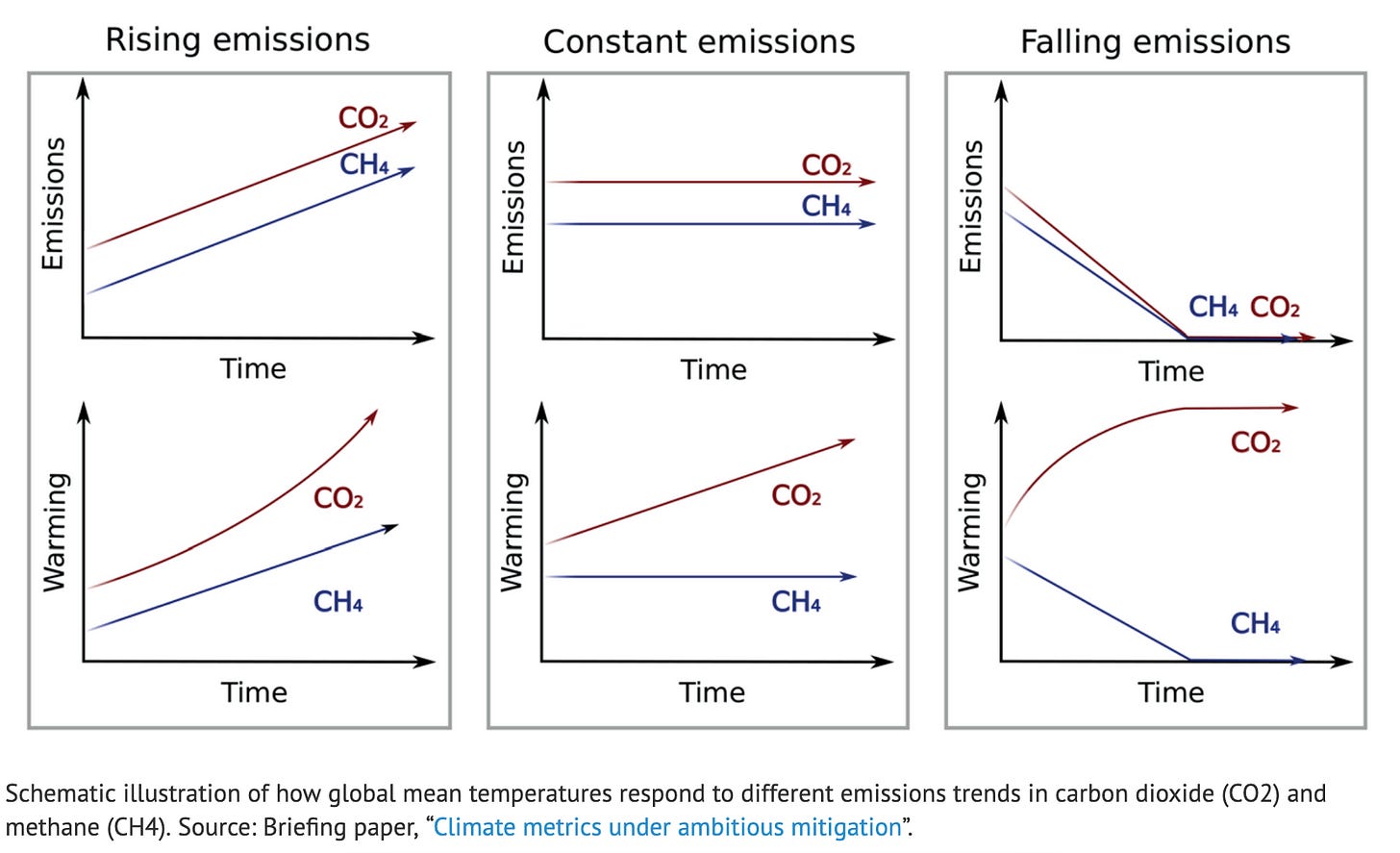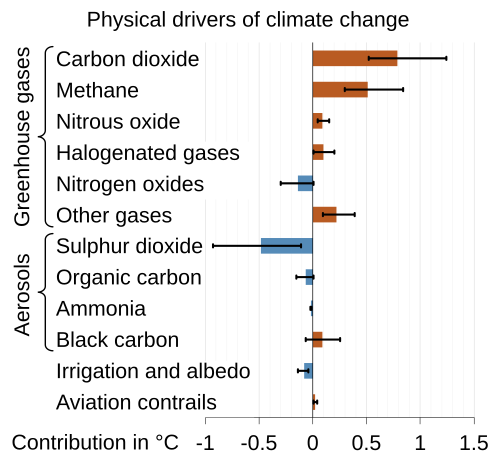CO2 and methane emissions need different policies
Short term warming is more effectively addressed with solar radiation management.
An example
It’s a summer day and the sun is shining right into your house, making it uncomfortably hot. You don’t have AC, so you buy a bag of ice from the grocery store. The ice slowly melts and stops your house from warming. But once it has melted your house gets hot again. You’re going to the store every hour just to keep the house cool.
An idea strikes: can you buy all the ice up front to save trips? You put a truckload of ice in your house only to find that it makes the house freezing cold. Once it melts, the temperature steadily rises until it’s hot again!
That evening, your roommate turns the oven on and the house starts getting hot. Fortunately the oven is only on for an hour, so you only need to make one trip for ice.
To maintain a desired temperature you need to match the flow of heat into the house with the flow of heat out. The sun heats over a long period. If you cool faster than the sun warms, the house will get cold. So you slowly introduce the ice over a whole day to avoid getting too cold.
The oven is much easier to deal with because it heats the house over a much shorter period. You only have to spend an hour bringing ice in.
CO2 vs methane (and other greenhouse gases)
In all cases, our goal is to stabilize global climate.
CO2 emissions are like the sun, they remain in the atmosphere for 1000 years. To cancel out the radiative forcing of a gigaton of CO2, you have to do something like stratospheric SO2 injection for 1000 years on a consistent schedule. That’s hard.
Fortunately, releasing a gigaton of CO2 and capturing a gigaton of CO2 somewhere else roughly cancels out. This might sound obvious, but the atmosphere is complicated and climate science only recently established this.
The upshot is that when CO2 emissions can’t be avoided, capturing the same amount with enhanced weathering neutralizes the threat.
Methane emissions are a different beast. Methane warms the atmosphere at a much faster rate, but only does so for about 10 years1. Mitigating this with CO2 capture is kind of awkward. In theory you could remove enough CO2 that there’s no net forcing for the next 10 years and then release most of it back to avoid overcooling, but that’s difficult and expensive.
Because the time period is so short, SO2 injection is actually feasible. You just need to inject SO2 on a 10 year schedule. In addition to being easier than CO2 capture, SO2 injection is far cheaper than CO2 capture will ever be2.
Other greenhouse gases fall into these two categories. If their lifetime is long like CO2, then they should be neutralized with CO2 capture. Gases with a short lifetime like methane can be countered with SO2 injection.
Fortunately, most other pollutants only have a small contribution to warming and are falling in atmospheric concentration. Wikipedia has a nice table on this.
Constant emission of short lived pollutants
If a gas like methane is released at a constant rate, then the concentration of methane in the atmosphere will stay constant. This is a consequence of the methane leaving the atmosphere relatively quickly.
A persistent concentration of methane means that the equilibrium temperature of Earth’s atmosphere is higher by a constant amount. That means you need to have a constant stream of SO2 injection to maintain your desired, cooler temperature.
This is not true for CO2. Each gigaton sticks around, warming the planet. A constant stream of CO2 means an increasing CO2 concentration. That means the equilibrium temperature of the atmosphere will continue to rise.

Conclusion
CO2 needs a different treatment than other greenhouse gases like methane. Carbon capture is required to mitigate the 1000 year heating created by excess CO2. Short lived pollutants are more manageable. You can cancel out the warming they create with SO2 injection and wait for them to leave34. This is much cheaper than carbon capture.
To be clear, we still need a lot more research on SO2 injection’s lifetime, effects on crop yields, and cost effectiveness. Assuming that all checks out, I think it is justifiable to do some reverse geoengineering to mitigate the geoengineering we have already done.
The science around short lived is mostly agreed-upon. But the policy implications I’ve esposed here (namely, that SO2 injection should be used to counter short lived pollutants) is the subject of ongoing debate. Particularly with respect to emissions from livestock. I’ll discuss this more in a future post, but for now this article is a good starting point.
At which point it has mostly turned into atmospheric CO2.
What’s the cheapest way to do this? Perhaps a hydrogen balloon carrying a stick of sulfur and oxidizer up to be burned in the stratosphere. The balloon can be tethered for reuse using a high specific strength string. Glass fibers similar to fiber optic cables seem like a good bet. Locating near the equatior and making sure the atmospheric winds send the SO2 out over the ocean is a good idea. Locating in Mexico or Venezuela fits the bill and gives you easy access to their sulfur mines.
Not that we should ignore opportunities to reduce these emissions. Preventing these emissions can be more cost effective per unit of cooling than lowering CO2 emissions due to their higher global warming potential.
You could batch these missions and time them so that they preferentially cool during the northern hemispheres summer.



What about just not releasing the methane? It's not like CO2 in that is gets emitted as a consequence of an otherwise useful process (combustion). A tax on methane emission ought to be super effective since it's already advantageous to use not emit it.